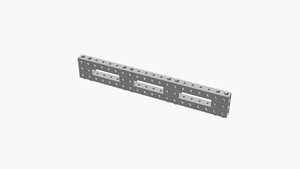Trusses: Difference between revisions
From
No edit summary |
No edit summary |
||
| (18 intermediate revisions by the same user not shown) | |||
| Line 1: | Line 1: | ||
{{Techniques infobox | {{Techniques infobox | ||
|image = | |image = Truss-spacers.scad.png | ||
| | |designers = Phil and RJ Jergenson, [[User:Tim|Timothy Schmidt]] | ||
| | |date = | ||
|parts | |vitamins = | ||
|techniques | |materials = | ||
|tools | |transformations = | ||
|lifecycles = | |||
|parts = [[Frames]], [[Nuts]], [[Bolts]], [[End caps]] | |||
|techniques = [[Bolting]], [[Triangles]] | |||
|tools = [[Wrenches]] | |||
|git = | |||
|files = | |||
|suppliers = | |||
|reversible = true | |||
}} | }} | ||
[[Category:Techniques]] | |||
=Introduction= | =Introduction= | ||
A truss consists of | A truss consists of [[frames]] connected at joints. Trusses are typically composed of triangles because of the structural stability of that shape and design. | ||
=Challenges= | =Challenges= | ||
A triangle is the simplest geometric figure that will not change shape when the lengths of the sides are fixed. In comparison, both the angles and the lengths of a four-sided figure must be fixed for it to retain its shape. | |||
=Approaches= | =Approaches= | ||
<gallery> | <gallery> | ||
Truss-simple.scad.png|Simple truss | |||
Truss-spacers.scad.png|Truss with spacers or [[stacked washers]] | |||
Truss-craftsman.scad.png|Truss with [[tri joints]] | |||
</gallery> | </gallery> | ||
* 2, 3, 4, 5 wide for similar function as 2040, 2060, 2080, 20100 extrusions. bolted across in an alternating diamond pattern for widths > 3 and bolt-length of 3. | |||
=References= | =References= | ||
* [https://en.wikipedia.org/wiki/Truss Truss] | * [https://en.wikipedia.org/wiki/Truss Wikipedia: Truss] | ||
* [https://en.wikipedia.org/wiki/Space_frame Space frame] | * [https://en.wikipedia.org/wiki/Space_frame Wikipedia: Space frame] | ||
Latest revision as of 17:58, 23 October 2021
Technique: Trusses
| Reusability | Reversible |
|---|---|
| Designers: | Phil and RJ Jergenson, Timothy Schmidt |
| Tools: | Wrenches |
| Parts: | Frames, Nuts, Bolts, End caps |
| Techniques: | Bolting, Triangles |
Introduction
A truss consists of frames connected at joints. Trusses are typically composed of triangles because of the structural stability of that shape and design.
Challenges
A triangle is the simplest geometric figure that will not change shape when the lengths of the sides are fixed. In comparison, both the angles and the lengths of a four-sided figure must be fixed for it to retain its shape.
Approaches
-
Simple truss
-
Truss with spacers or stacked washers
-
Truss with tri joints
- 2, 3, 4, 5 wide for similar function as 2040, 2060, 2080, 20100 extrusions. bolted across in an alternating diamond pattern for widths > 3 and bolt-length of 3.



